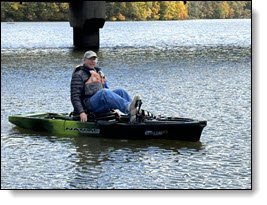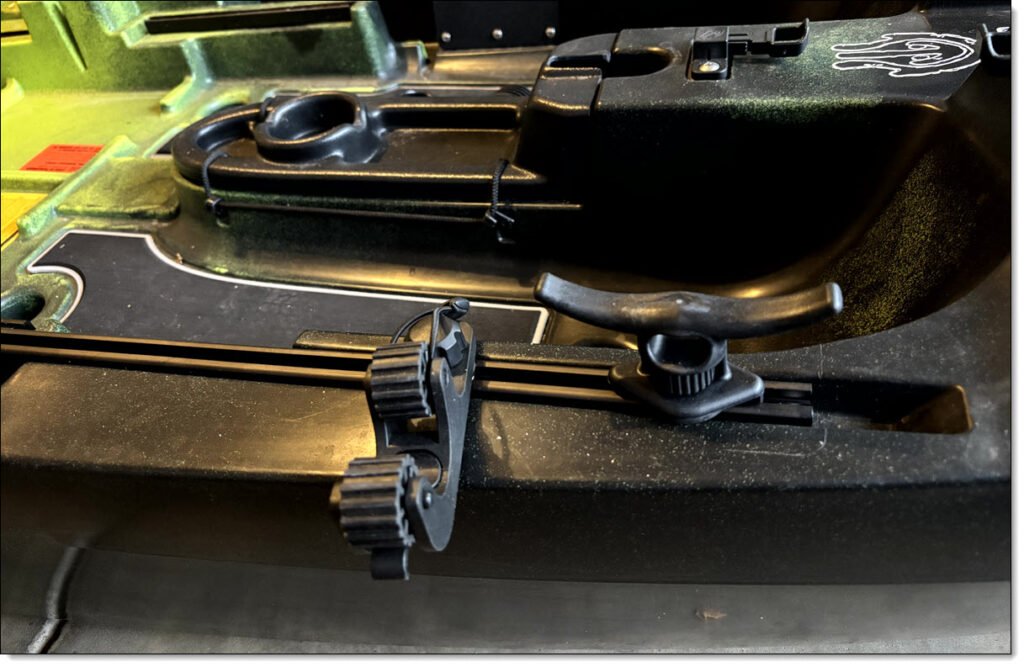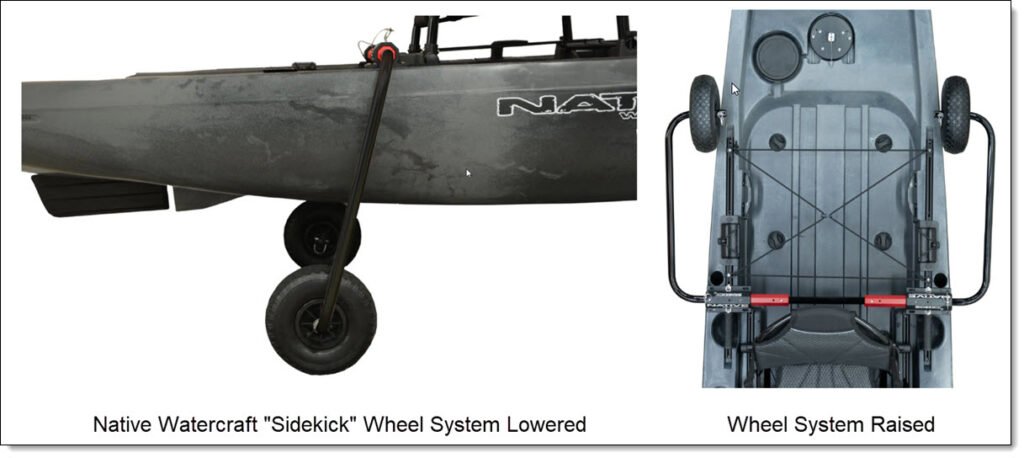
Estimated reading time: 15 minutes
Last October Winnie and I added a Native Watercraft model “Slayer Max Propel 10” pedal-drive kayak to our fleet. We’ve used this kayak several times since, enough for me to post a review.
Although these pedal drive kayaks are designed for serious fishing, my review will not be on the fishing capabilities of this boat. My review is written for kayakers who are pedal-curious and thinking about expanding their kayaking fleet.
Summary Up Front
| | |
|---|---|
| Excellent Stability | Heavy |
| Good Tracking | Difficult to Transport (Weight, Size, Keel Shape) |
| Easy Seating Access (Sit-on-Top) | Pedal Drive and Rudder Requires Special Tools for Maintenance |
| Lots of Storage | Does Not Paddle Well Due to Weight |
| Fun to Pedal | Requires Relatively Deeper Water than Conventional Kayaks of Same Size |
| Easy To Add Accessories |
Description
The Slayer Max Propel 10 is classed as a single-seat . One key feature of this style boat is the extensive use of tracks that allow accessories to be mounted without drilling holes in the hull.
There is a wide range of third-party accessories suitable for track-mounting including cleats, cellphone/GoPro holders, and of course all types of fishing-related accessories. I’ve come to call my Slayer Max Propel 10 a “gadget boat” for all the different accessories I can customize it with. Which, for a gadget-person like me, adds to the fun of owning and using this boat.

The most significant feature of this boat is the pedal-drive (“Propel”) unit. The Propel is mounted just forward of the kayak seat, and has two main sections. The upper section is a set of bicycle-style pedals connected to a gearbox, with a shaft that extends below the bottom of the kayak. The lower unit is another gearbox with two-blade propellor (“prop”). The pedals turn the prop with a 10:1 gear ratio – meaning one rotation of the pedals turns the prop ten times. The Propel drive can be easily raised for shallow-water cruising.
The boat is also capable of being paddled like a standard kayak, and a rudimentary paddle holder is built-in to the boat’s stern. The boat is steered using a drop-down rear-mounted rudder. The rudder is controlled by a hand-operated lever positioned by the user’s left hand.
Specifications
The Slayer Max Propel 10 is 10 feet (120 inches) long by 34.15 inches wide. The “fitted” (bare hull) weight including attached accessory tracks and rudder assembly is 75 pounds. The hull weighs 97 pounds fully rigged with the Propel drive and seat. Native Watercraft advertises this as the lightest kayak of its class on the market.
Rated weight capacity is 400lbs (181 kg). Draft is 14 inches with the Propel drive and rudder lowered. Starting with the 2023 model year, this boat includes a SpringBlade rudder system. Standard hull features include:
- Propel Pedal Drive 701 Series.
- Hand-operated rudder.
- Hand-Sewn Adjustable Seat.
- (Note: Starting in 2025 this is a swivel seat)
- Eight deck with plugs.
- Hand carry grips on bow, stern, and on both sides amidships.
- Anti-Slip Standing Pads.
- On-Board Storage:
- Three molded in vertical fishing rod holders.
- Dual horizontal fishing rod storage.
- Dual side tackle storage pockets.
- Under-seat tackle storage drawer.
- Split paddle storage.
- Rear deck dry storage compartment.
- Rear storage area with ribbed deck
- Bow storage compartment with hinged hatch cover.
- Provides battery storage and transducer access
- Accessories Support:
- Accessory mounting tracks .
- Bow-mount transducer pocket.
- Dual electronics switch mounting plates.
- Stern mounting for a power-pole micro or motor.
Note that the standard kit does not include a paddle. Although the Propel drive is standard, you’ll want a paddle as backup propulsion, such as for places where the water is too shallow for the Propel drive to be lowered.
The 2023 – 2024 model years feature four “camouflage” patterned two-tone hull color options; green, grey, beige, and blue.
Storage
The boat’s weight adds to the complexity of storing a hardshell kayak. Note that the drop-down rudder needs protection from pressure, and the bow dips below the rest of the hull. If you keep the entire kit of Propel drive and seat mounted on the hull, then you will have difficulty storing anything above it due to total height.
I’ve opted for storing my boat on a set of sawhorses, or on the floor resting on a protective pad. The sawhorses also provides double-duty as workrack for cleaning and working on the boat.
Transportation
Weight is a significant consideration with this type of boat. Moving the kayak around over dry land takes some planning and handling equipment. I believe moving and transportation options are a critical part of a purchase decision on this kayak.
Local Moving
Neither my wife nor I are individually capable of lifting and carrying around a boat this large and heavy. The boat does come with solid hand grips in the middle on both sides, and solid hand grips in the bow and stern. With two people, we can move the boat around our yard.
One Native Watercraft accessory option for this boat is a wheel system that remains attached to the rear accessory tracks. The wheels swing down when you need to move the boat around on land, then swing up when you’re in the water. I’ve seen the Native Watercraft accessory sidekick system in use and consider it an effective dolly option. But, it adds weight to the boat and increases total width. I also think showing side wheels while pedaling/paddling makes the boat look sloppy.

Other options are third-party kayak dollies that can be positioned under the boat to wheel it around, then removing the dolly once the boat is in the water. I opted for a third-party kayak dolly, with the thought I could also use it for my other kayak. I found that this dolly works well for rolling the boat around. However, getting the dolly off once the boat is in the water is wet and awkward.
Over Roads
The boat’s shape makes transportation difficult. The flat bottom and squared sides does not fit a standard kayak “J-rack” cradle. Weight is another factor. I’m sure there are athletically-capable people who can load a 75 pound boat on top of their car. Neither my wife nor I are among these people.
I have seen people load kayaks up to 12 feet long in the back of a pickup truck (tailgate up or down) with a large amount of the kayak hanging out the back end. The kayak section inside the pickup truck bed is tied down, and overall this setup seems to work ok. You will need to hang a red flag off the kayak end sticking out.
You could also use a trailer. There are dozens of different commercial kayak trailers available. Or, you can build your own. I opted to modify a 5’x8′ single-axle utility trailer we already owned into a kayak carrier. This trailer is wide enough to carry two kayaks, so now we also carry our Trophy 126 on it. Although our Trophy 126 is light enough to car-top, it’s nice to have an alternative transport option.
Our trailer setup allows us to back the trailer down a boat ramp into the water and float the kayaks off. Which also alleviates the issue of removing a kayak dolly while the boat is floating.
On The Water
Once you’ve gotten this boat into the water the fun begins. This boat is comfortable, handles well, and has a lot of storage options.
Stability
The roots of this boat as a fishing platform really shows in the excellent stability. The boat is stable enough for stand-up fishing in calm waters. Using an assist pull-up strap tied to the boat’s front handgrip does help me with getting up from my seat. I would not attempt to stand up in any kind of rough water, but that’s just me. I think someone with a lot of experience would have no problems maintaining their balance standing up in this boat, even in moderately rough water.
The stability combined with seat elevation is great for staying dry while going out into choppy water.
Seating
The seat can slide to adjust your leg distance from the pedals. There’s ample adjustment range to account for my long legs, and for my wife’s short legs. In addition to adjusting for pedal clearance, the seat back can also adjust for leaning back. Altogether, this seat is by far the most comfortable kayak seat I’ve tried. You’re also sitting up high, which greatly helps getting on and off the boat.
Propel Drive
As a long-time bicycle enthusiast, pedaling this boat is a blast. It’s also a serious lower-body workout. Unlike a bicycle, there’s no downhill coasting pause when you can rest your legs. There’s also no gearing available to change the amount of force needed to pedal along. On the flip side, I can move a lot faster with the Propel drive then I’ve ever moved a kayak while paddling.
Paddling
At some point you’re going to need to use a conventional kayak paddle. Whether beaching the boat or just venturing into thin water, the 14 inch draft does limit use of the Propel drive. The Propel drive can be easily swung up out of the water on its forward support when not needed.
Paddling performance does not compare well to a not-Propel-drive kayak. The boat’s weight is especially noticeable, as well as the extra shoulder power needed for high-angle paddle strokes with a long paddle. But, the boat does move on paddle power alone. I’ve found that if I alternate between peddling and paddling, I can get a pretty complete full-body workout during a day of kayaking.
Paddle Holder
The boat includes a “split” rear paddle holder, which I consider useless. The concept is that you split your paddle, reach all the way to the back of the boat, and snap each paddle half into the holder. Then, when you need the paddle you reach back, grab each half, assemble the paddle, and start paddling.

As another option, if you’re not fishing, you can disassemble the paddle and stick each half into the included fishing rod holders. Which at least makes it easier to grab the paddle halves when you need them. But, still awkward. I opted to use space on my accessory tracks to mount pair of paddle holders that extend (“offset”) past the side of the boat. Now my paddle is assembled and within reach for quickly shifting between pedaling and paddling.

Sizing Your Paddle
Another consideration for paddling is that, due to the boat’s width and seating height, you’ll need a longer paddle then most kayaks require, with a high-angle blade shape. Using a too-short paddle results in awkward paddling strokes. I found that with a correctly-sized paddle, I could keep up with my wife paddling our Trophy 126 kayak. But, it is a workout.
Tracking
The boat has excellent tracking, both on pedals and paddling. Steering is managed with the drop-down rudder and a hand control. While on the Propel drive, turn the rudder in your desired direction of travel and the boat will go there. Keep the rudder straight, and the boat runs in a perfectly straight line.
As the rudder is a drop-down style, I’ve experimented with using it in the raised and lowered position. In the raised position it appears to work more as part of the keel and has minimal steering control. Once lowered, the rudder offers excellent steering. It does take some getting used to steering with a hand control.
If you’re paddling then you’ll want to raise the rudder. It’s important to be sure the rudder is straight inline with the boat’s keel, else you will tend to drift in the direction the rudder is pointed. Otherwise, the same skills and principles for steering a kayak apply when paddling this Slayer Max Propel 10.
On-Board Storage
This boat excels in providing usable, accessible on-board storage. There’s a slide-out storage drawer under the seat, along with additional storage on the deck under the seat. There are side pockets specifically sized for fishing tackle boxes on each side of the seat, a molded-in drink holder, a covered storage bin in the bow and dry storage at the stern. All this is in addition to the large rear storage deck, which can easily support a family-sized cooler or milk crate storage box.
Accessories
Being able to easily add custom components without drilling holes is a big plus for me. I have not started fishing off this boat yet, so haven’t tried “optimizing” it with all the hi-tech fishing tackle modern day fish require. But, I have added a pair of offset paddle holders, tie-downs for my rear deck milk crate storage box, a portable fishfinder mount, and a set of four cleats.
Fishfinder
I’ve also added a small, inexpensive depth/fishfinder. One really interesting feature of this boat is a recessed pocket under the bow for adding a fishfinder transducer. I don’t need an elaborate fish finder (yet), but knowing bottom depth is useful on a kayak with 14 inch draft. I already owned a hand-held fishfinder, and was able to mount the transducer inside the bow pocket, run the wire up through the wiring channel, and attach the display on a track-mounted holder. All without drilling any holes.
In addition to the accessory tracks, Native Watercraft included options for running wiring through the hull using replaceable plates for mounting electrical controls. The built-in front storage bin is large enough for a ten amp-hour battery, enough power for a day’s worth of advanced electronics and LED lighting.
Maintenance
One tradeoff with the Propel drive, rudder system, and numerous accessories on this boat is required maintenance. The Propel drive does require periodic lubrication, which requires several special tools. The rudder linkage requires periodic adjustment to compensate for cable stretching. If you add a battery for electronics, the battery will also require routine maintenance.
Durability
This kayak is manufactured as a thick one-piece hull. I’ve owned this boat for a year and have had no issues with the durability, fit, or finish. The accessory tracks are solidly mounted, all hatches and other add-on components fit well. Assuming regular factory-recommended maintenance, I feel comfortable saying I should expect many years of trouble-free use with this boat.
One maintenance issue I have seen involves scupper-mounted kayak dollies. The Slayer Max Propel 10 has eight scupper holes, four forward and four aft. There are a number of kayak dollies that are designed to hook into these scupper holes, instead of being strapped on. Hooking a dolly into these scupper holes creates stresses that the hull is not designed for. This may cause the hull to crack around the scupper holes, which probably voids the hull warranty.
Warranty and Service
The manufacturer offers a five-year warranty against manufacturing defects on the hull, and a five-year warranty on the 701 series Propel. But this extended warranty is only for the original purchaser. There are a number of caveats on the Propel warranty related to proper maintenance and registering your purchase.
Although you can purchase parts and accessories directly through the Native Watercraft website, the boats are sold only through their small retailer network. All initial servicing would be through these dealers.
Purchase Price
At the time of this review, the for a Slayer Propel Max 10 is $2,699. This includes the seat and Propel drive, but not a kayak paddle or Sidekick wheel system. Overall, this price compares favorably against other pedal-drive kayaks brands including Hobie and Old Town.
Conclusion
Overall, I consider this a solid, well-built boat with some very nice features. However, given the storage, transportation, and maintenance issues, I would not give up my conventional kayaks for this boat. The Native Watercraft series of boats are designed for fishing (and hunting) and I can see they are well-designed for these activities.
I like the Propel drive for lower body workouts. The boat is very stable, and offers extensive storage space. As a gadget person, I really do like having the ability to easily add extra accessories like cleats, fish finder, and even lighting without perforating my boat.
Unless your entire focus on watersports is fishing or hunting, this would be a boat you use as a complement to your existing kayak fleet.
Related Posts
- Review: Sea Eagle 370 Inflatable Kayak
- Review: HO Sports Beacon Inflatable Kayak
- Boating Hacks: Sea Eagle Inflatable Kayaks
- Small Boat Hacks: Anchoring
Updated: February 17, 2025, with “Summary Up Front” table
